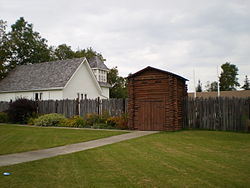| Fort Dauphin | |
|---|---|
| Near Winnipegosis, Manitoba | |
 Fort Dauphin Museum Fort Dauphin Museum | |
| Type | Fort |
| Site information | |
| Controlled by | France, Canada |
| National Historic Site of Canada | |
| Official name | Fort Dauphin National Historic Site of Canada |
| Designated | 1943 |
| Site history | |
| Built | 1741 |
| In use | 1741- |
| Materials | Wood |
Fort Dauphin was the name of two forts in Manitoba.
The first Fort Dauphin was built in 1741 near Winnipegosis, Manitoba, with Pierre Gaultier de La Vérendrye, the western military commander, directing construction. The area provided a post located between the Assiniboine River and the Saskatchewan River. It was named for the Dauphin prince of France.
A second Fort Dauphin was built in 1767 on the north shore of Lake Dauphin, so both the fort and the lake had the same name. This fort was built by French fur traders after the era of the western military commanders. As with many of the forts of the times, they kept the same names while changing locations to facilitate trade with the First Nations and to secure better physical locations.
The site at Winnipegosis was designated a National Historic Site of Canada in 1943.
References
- Fort Dauphin. Directory of Federal Heritage Designations. Parks Canada. Retrieved 20 May 2012.
Further reading
- Champagne, Antoine (1968–69). "The Vérendryes and Their Successors, 1727-1760". MHS Transactions. Series 3 (25). Manitoba Historical Society.
- Shaw, Edward C. (Autumn 1973). "La Vérendrye". Manitoba Pageant. 19 (1). Manitoba Historical Society.
External links
- "Manitoba Time Line (1610-1920)". Manitoba Historical Society. 24 September 2013.
| National Historic Sites of Canada by location | |
|---|---|
| Provinces | |
| Territories | |
| Other countries | |
51°39′17″N 99°55′26″W / 51.6546°N 99.9238°W / 51.6546; -99.9238
This article about a building or structure in Manitoba is a stub. You can help Misplaced Pages by expanding it. |
This New France-related article is a stub. You can help Misplaced Pages by expanding it. |
This military base or fortification article is a stub. You can help Misplaced Pages by expanding it. |